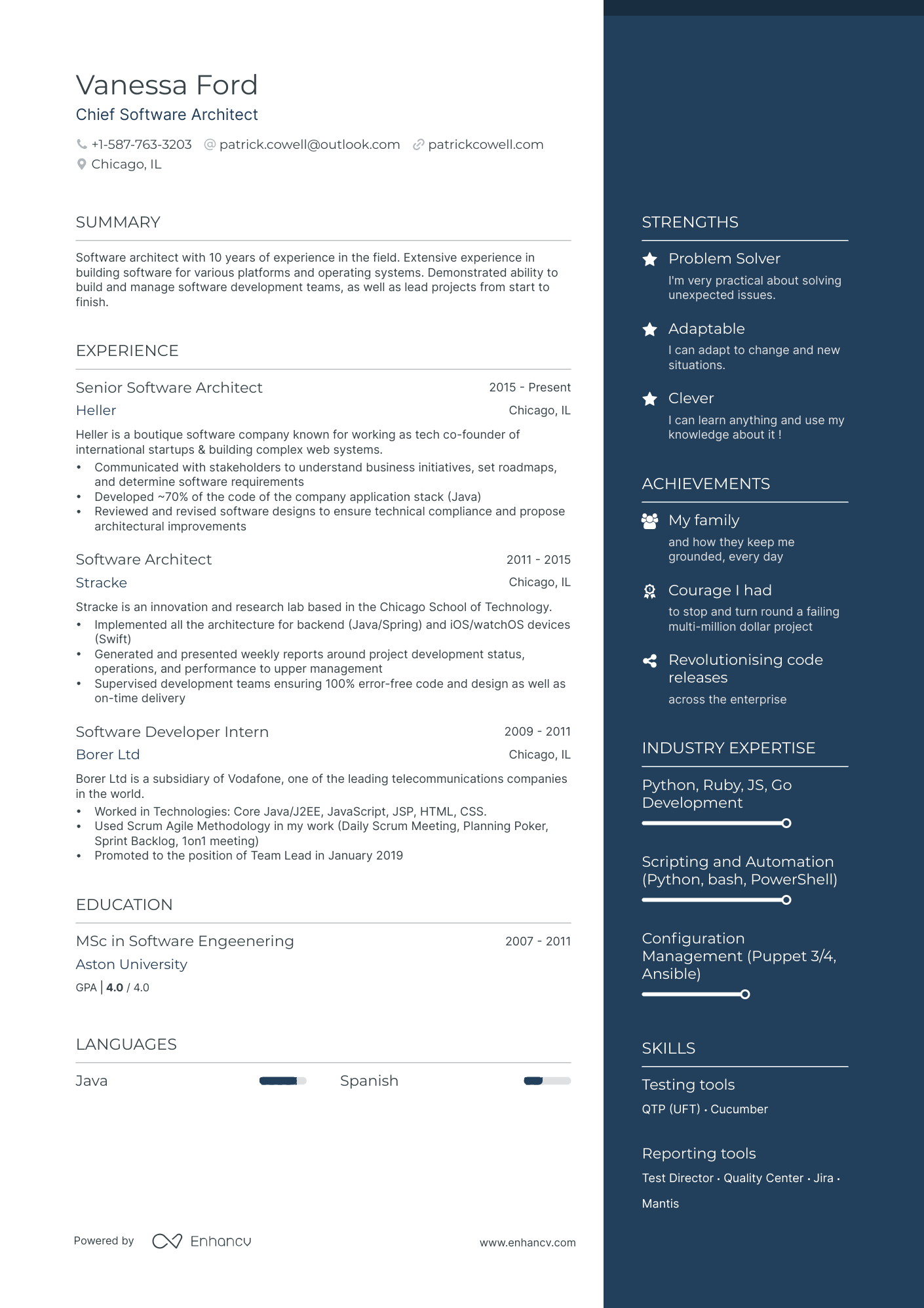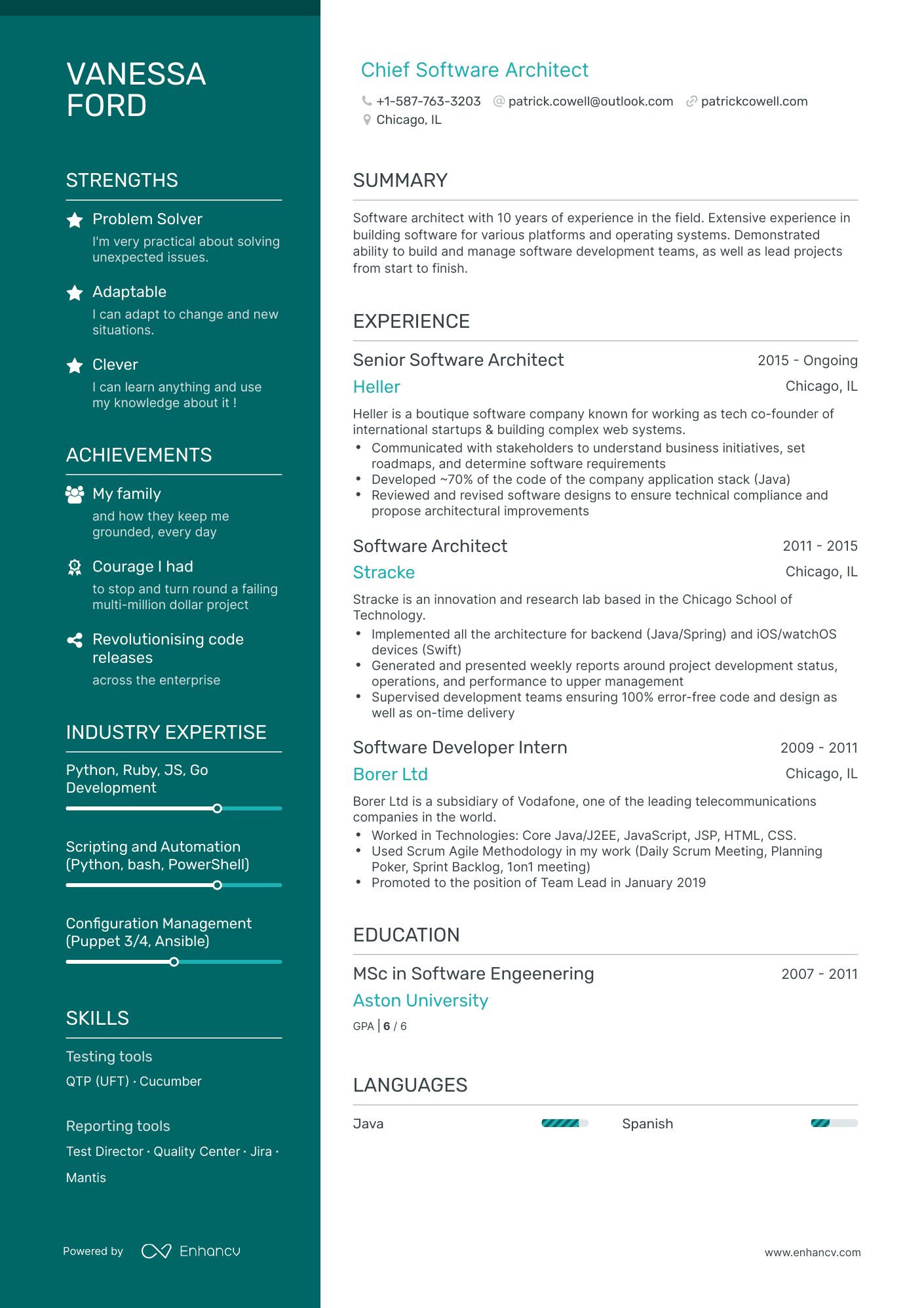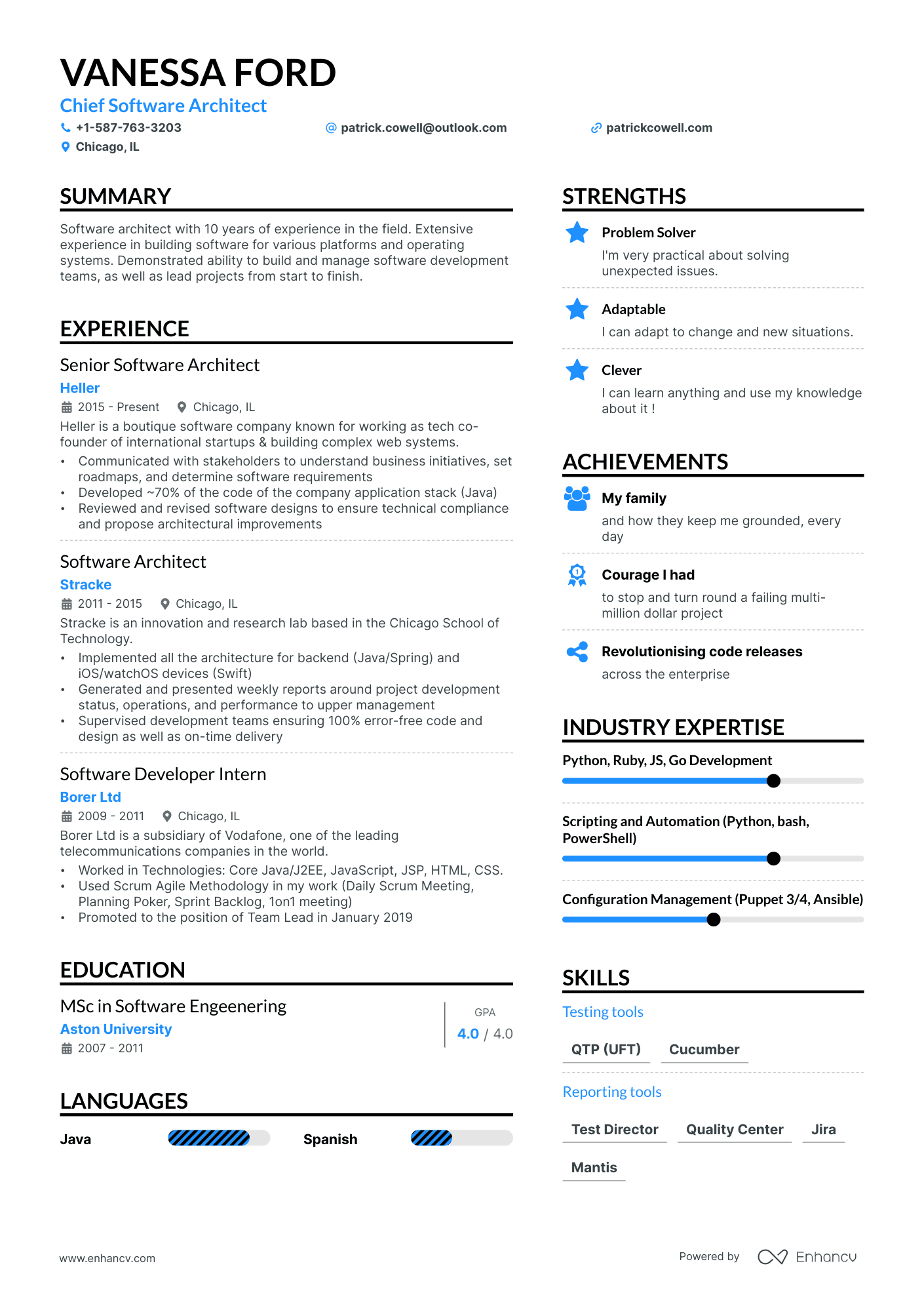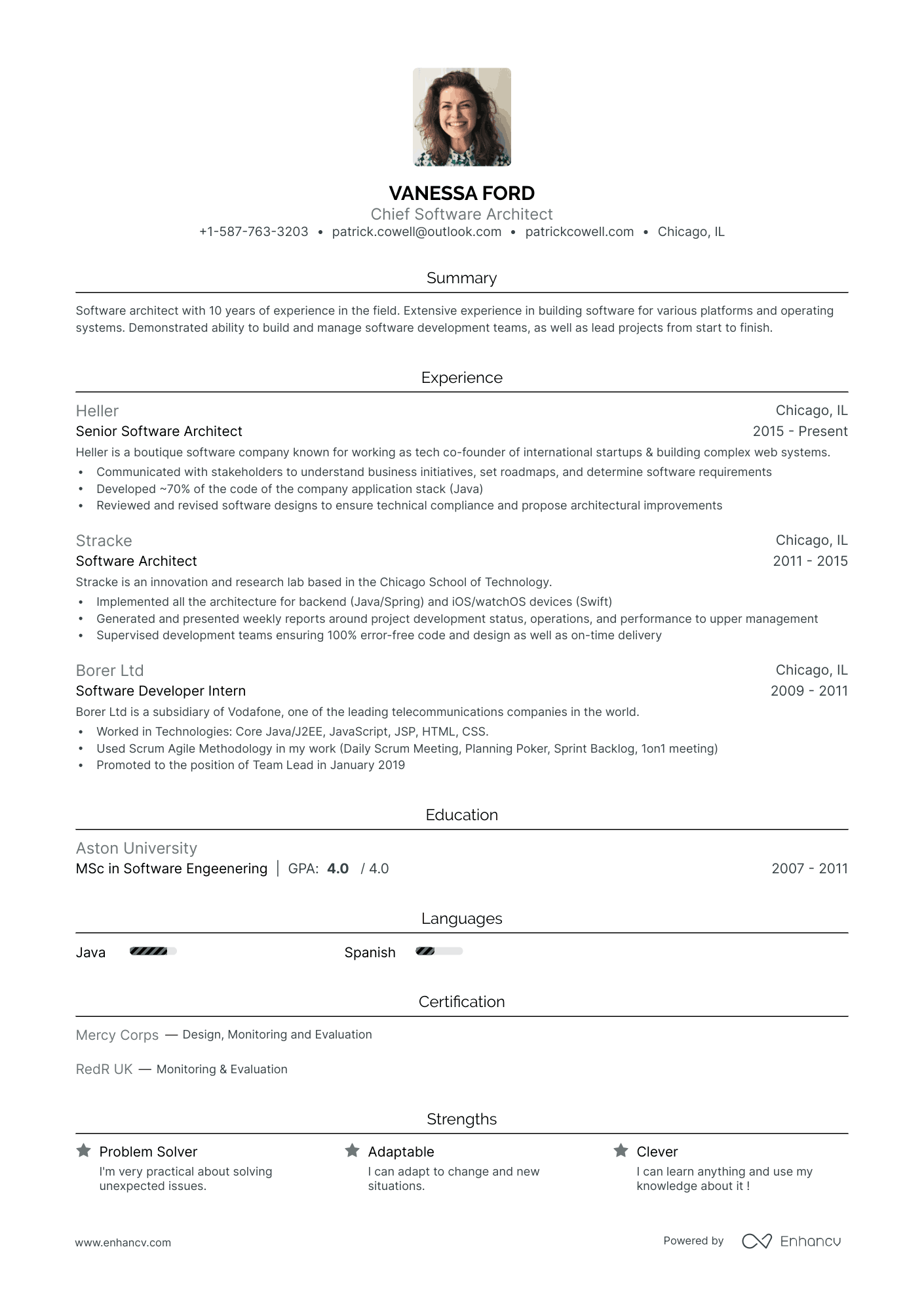Here to make a software architect resume that ends your job hunt?
Software architecture is a complex role. It takes lots of creativity and flexibility from an employee to thrive in such a position.
Your work is key to the development of software and the facilitation of communication between team members. And you also ensure the security, profitability, and performance of the software by planning everything ahead.
You have the right qualifications at hand. So, you can handle any given task and deliver exceptional results.
But…
Hiring managers don't know that about you.
In fact, that's what they're told every applicant they come across, which only creates more doubt. Every single candidate is claiming to be the best choice recruiters can make.
Because of that:
You need a software architect resume that answers all questions and helps you stand out.
Now, here's what you might be thinking:
Where to get started with making my resume? Will I have enough time to create one and use it to get hired?
To be honest with you:
Making a resume from scratch can be daunting for many job seekers.
You don't know which sections to include or how to feature your experience and skills. You have no idea what hiring companies are after and how to prove your competence.
Thankfully, you've come to the right place!
We wrote this guide to help you make a brilliant software architect resume in a timely fashion. We'll share expert-driven tips on how to land the job you want by promoting yourself as a professional candidate.
In this guide, you'll learn:
- How to structure your resume and pick the best format to organize your sections
- Expert tips on making a header that keeps recruiters glued to your profile
- The right way to showcase your work experience by featuring skills and accomplishments
- Most sought-after soft/technical skills and how to use them to inspire hiring managers
- Additional sections to make your resume unique and show your personality
Looking for Related Resumes?
How to Write a Powerful Software Architect Resume
Recruiters rely on a specific set of requirements to find their perfect candidate. They know everything about your job and what it takes to succeed in software architecture.
Still…
They have to skim through hundreds of resumes before choosing the right applicant. After that, they'll narrow down their initial list to a few candidates. Finally, they have to interview them all before making a hiring decision.
Because of all that…
You need to help them find you in a pile of hundreds of resumes. And the only way you can do that is by being different but in the right way.
To get started:
You need to pick a resume format that best shows your qualifications.
There are various formats to choose from. The multitude of options can leave you paralyzed for days without a single step forward.
So, here's some expert advice for you:
A reverse-chronological format is the most popular one in the job market today, and it will work best for you. It's the most effective in highlighting your work experience and proving your skills.
The way this format works is simple:
You'll start by featuring your most recent job experience and go back in time from there.
Take a look at the resume sample at the top to get a better idea.
Next:
Stick to a standard resume layout with many sections organized within a single page. Then, add clear subheadings on top of each section. And leave a lot of white space around your text to make it more skimmable.
You can get more creative with your layout and use different colors. But, be sure to maintain a structure that helps recruiters scan your resume in 7 seconds.
Finally:
You have to save your resume in a PDF format.
It's the most popular resume format today because most companies ask for it in the job offer. That's because it will maintain your resume formatting, fonts, and structure over time.
Which sections should you include in a software engineer resume?
- Header
- Experience
- Skills
- Education
- Languages
What recruiters expect to see in a software architect resume
- Relevant work experience to help you efficiently develop and maintain successful products
- The soft skills required to solve complex technical problems, communicate, and work well within teams
- Quantifiable achievements and work results (e.g., Integrated scrum and led a cross-functional team of 3-8 resources)
- Technical abilities to help you develop accurate software blueprints and determine design choices
- Extensive knowledge of tools and technologies to ensure the highest levels of quality and productivity
For more information on the best resume format options, read our guide: The Best Resume Formats You Need to Consider (5+ Examples Included).
Software Architect
resume header: best way to write it
The header isn’t the best place to be creative in your resume. You must give recruiters precisely what they’re looking for here so they can move on to other important sections.
Also:
This is not an essential part of your resume in terms of decision making.
So rationally speaking, a bad header shouldn’t sabotage your job hunt or keep you unemployed. After all, it doesn’t contain much information related to the job position.
However…
Headhunters are only human, and they’re bound to make mistakes without knowing it.
When the competition is fierce, a recruiter might prefer to hire someone just because their email address looked more professional.
Therefore:
You don’t want to leave any unnecessary negative impressions on the person responsible for your employment.
Here are the key details to include in your resume header:
- Full name
- Job title
- Phone number
- Email address
- Location
Make sure to use a professional email address featuring your first and last name.
Stay away from email addresses that look like an online gaming alias. And never feature your current work email address.
Let’s see an example now:
With a couple of improvements, the previous example will be ready to go.
First:
Let's use a more professional email address.
Create a new address if you don't already have one. And be sure to use popular email providers such as Gmail and Outlook.
Also:
As a software architect, recruiters would love to look at your previous projects.
So, it's always great to feature a link to your website, portfolio, or LinkedIn profile.
You'll give headhunters an option to learn more about you even after reading your whole resume. That might put you at an advantage compared to others who can only claim competence without proof.
If you want more ideas for stand-out resume headers, read through our guide Perfecting Your Resume Header so You Get Noticed.
How to Feature Your Experience As a Software Architect
Do you know what all job-winning software architect resumes have in common?
A professionally presented work experience.
It's what recruiters are after in your resume and what will convince them of your worth.
Get this:
We recently reviewed 114,000 resume examples and job offers.
What we found is that the average experience for a software architect required by employers is 4.4 years. However, the experience on software architect resumes is around 3.2 years.
That makes software architects slightly underqualified.
These facts might leave you a bit devastated. But don't get discouraged!
Impact-oriented resumes have a higher chance of getting you hired than vague resumes with more experience.
And that's what we're going to teach in this part.
For starters:
software architecture is a creative job position with lots of duties to manage. Two software architects can handle entirely different tasks over time and still hold the same job title.
So, you should pick the most relevant duties based on the job application.
Ask yourself:
- Why is the company hiring?
- Which essential responsibilities do they need help with the most?
- What skills, tools, and technologies are they highlighting in the job offer?
Answering these questions should help you gain more clarity and feature the right responsibilities.
Next:
You have to think about the right way to structure your experience.
We said it earlier in this guide. It's best to keep everything chronological.
Start from the most recent job position and continue further down. That helps headhunters better notice your positive career progression.
Finally:
Your experience section is often the one a potential employer looks at first. So keep in mind that the rule of a thumb is to show rather than tell.
Make each bullet point in your experience section count. The way you'll do that is by mentioning the impact you had in your previous positions.
Stay away from simple duties and focus on effectiveness and results.
- •Responsible for the adaptability to technical features
- •Led the development of new technologies in an Agile environment
- •Handled internal communications between team members
Let's make a few changes to make this example even better.
Your recruiters have read thousands of resumes where duties aren't backed up by any concrete numbers. They know that anyone can claim brilliance, but very few can do the job properly.
Consequently:
They don't want to hear about another basic responsibility you can handle. They're more interested in what you've done and the results you achieved.
So:
Be sure to include tangible metrics and precise numbers to solidify your claims. Also, remember to feature your most important skills and technologies to prove your fitness for the job.
More importantly:
You must use action verbs and keep a direct language when describing your experience.
For example, instead of saying:
- Handled
- Responsible for
- Helped with
Try to go for active verbs, like:
- Designed
- Launched
- Initiated
- Improved
- Generated
These words are strong enough to leave a good impression and prove direct causality. They also allow you to vary your vocabulary to allow a natural flow of words.
Let's try again and see how the example turns out:
- •Developed ~70% of the code of the company application stack (Java)
- •Reviewed and revised software designs to ensure technical compliance and propose architectural improvements
- •Supervised development teams ensuring 100% error-free code and design as well as on-time delivery
For more ideas on how to create an actionable resume experience section, check out our guide How to Describe Your Resume Work Experience.
Software Architect Resume: Top Soft and Technical Skills to Showcase
Skills are critical to showing your relevant work experience and qualifications.
That's why you shouldn't just Google "top skills for software architects" and add everything that comes your way to this section.
Instead:
You need to be smart about which abilities the job position requires. And you must understand the importance of each skill you feature here.
So that might leave you wondering…
How do I decide on what skills to showcase on my resume? And how can I be different from everyone else?
No worries!
The solution to that is quite simple. All you have to do is follow these steps:
- Make a list of every skill you possess as an applicant.
- Read the job application to identify the skills most wanted by the hiring company, then make a list of that too.
- Find the overlap between the two lists and pick the most critical skills to help you excel at your job.
It's better to split and organize your lists into soft and technical skills to stay organized in your job hunt.
To make things easier for you, we've hand-picked a list of the most sought-after software architect skills in the market today.
Top 12 technical skills for software architects
- Java
- Python
- Solution architecture
- Algorithms
- Project management
- Kotlin
- Software development
- AngularJS
- JSON
- Microsoft Azure
- .NET Framework
- Amazon Web Services (AWS)
Best 13 soft skills to add to your software architect resume
- Attention to detail
- Time management
- Creativity
- Teamwork
- Critical-thinking
- Collaboration
- Decision-making
- Communication
- Analytical skills
- Discipline
- Reliability
- Solution-oriented
- Multi-tasking
Are you still not sure what skills will win recruiters over? Check out our guide on How to Create A Resume Skills Section To Impress Recruiters (+10 Examples You Need to See).
Software Architect Resume: Additional Sections
Adding more sections to your resume allows you to better connect with recruiters by showing your personality. It’s also a great way to fill your resume and make it more interesting.
But be careful:
Additional sections are tricky and can have a negative effect on your job application.
You must be picky about what sections to include. And you also need to understand what each section means to recruiters.
Here are some additional sections to add to your software architect resume:
Day in my life, passions, hobbies, languages
In our experience, adding more personality to your resume is an excellent way to stand out.
Employers are far more likely to remember candidates with real human characteristics. They don't want to just deal with a list of responsibilities but also know the person behind them.
That's how you prove your authenticity.
Add passions, share your favorite books, or even what your typical day looks like to catch their attention and make them fall in love with you.
Proudest achievements
Did you learn a language on your own? Have you won any awards or trophies? Were you able to save a failing company after getting hired?
This is where you'll feature all those fantastic achievements.
Different life situations can teach us so many skills! It's worth mentioning some of them on your software architect resume.
You can also share a story about overcoming hardship, learning an important life lesson, or just a triumph that means a lot to you.
Either way, "Most Proud Of" is the best place to make your software architect resume shine.
For even more tips and advice about additional sections to your software architect resume, check out our guides:
- Language skills
- Hobbies and interests
- Projects
- Summary
- Education
- Certifications
- Volunteer work
- Highlights
- References
- LinkedIn on Resume
- GPA
Software Architect Resume: Key Takeaways
- Take your time reading the job description and identify the key duties, skills, or requirements to help you stand out as the perfect candidate.
- Pay attention to your resume structure and formatting to grab the recruiter’s attention and keep them glued to your profile.
- Only feature your relevant work experience through career accomplishments and tangible results.
- Pick the most sought-after technical and soft skills to highlight the overlap between your qualifications and the job requirements.
- Show your personality through additional sections (languages, proudest accomplishments, hobbies, etc.) to leave a lasting positive impression.




